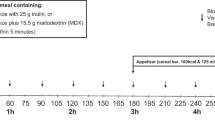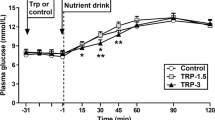Abstract
Objective:
The ileal brake is a feedback mechanism activated by nutrients, especially fat, with marked effects on satiety. The effects of low doses of ileal fat on satiety are largely unknown. We therefore studied the effect of ileal vs oral delivery of low doses of fat on satiety and gut peptide secretion.
Design:
Randomized, single-blind crossover design.
Subjects:
Sixteen healthy, normal-weight volunteers (6 male; mean age 26 years, mean body mass index 22.4).
Intervention:
Participants were intubated with a 290-cm-long nasoileal tube and consumed, on 3 consecutive days, either a liquid breakfast with 3 g fat followed by an ileal placebo infusion at t=105–150 min (treatment C) or a fat-free liquid breakfast followed by an ileal infusion of either an emulsion of 3 g (treatment I3g) or 9 g (treatment I9g) fat (safflower oil).
Measurements:
Satiety parameters by visual analog scales and plasma concentrations of CCK and PYY.
Results:
C significantly increased satiety and CCK secretion compared with the fat-free breakfast. Ileal fat perfusion of both 3 and 9 g (I3g and I9g) significantly increased satiety during and after fat perfusion, without differences in satiety between I3g and I9g. During ileal fat infusion, CCK increased dose dependently, whereas PYY concentrations increased significantly only after 9 g of fat. Secretion of CCK but not of PYY correlated to satiety levels.
Conclusion:
Postprandial satiety following a liquid breakfast can be effectively and significantly increased by small amounts (as little as 3 g) of fat perfused into the ileum. Ileal fat dose-dependently increased CCK but not PYY secretion. The satiating effect of ileal fat may be partly mediated by CCK.
This is a preview of subscription content, access via your institution
Access options
Subscribe to this journal
Receive 12 print issues and online access
$259.00 per year
only $21.58 per issue
Buy this article
- Purchase on Springer Link
- Instant access to full article PDF
Prices may be subject to local taxes which are calculated during checkout






Similar content being viewed by others
References
Woods SC . Gastrointestinal satiety signals I. An overview of gastrointestinal signals that influence food intake. Am J Physiol Gastrointest Liver Physiol 2004; 286: G7–G13.
Geliebter A . Gastric distension and gastric capacity in relation to food intake in humans. Physiol Behav 1988; 44: 665–668.
Jones KL, Doran SM, Hveem K, Bartholomeusz FD, Morley JE, Sun WM et al. Relation between postprandial satiation and antral area in normal subjects. Am J Clin Nutr 1997; 66: 127–132.
Hveem K, Jones KL, Chatterton BE, Horowitz M . Scintigraphic measurement of gastric emptying and ultrasonographic assessment of antral area: relation to appetite. Gut 1996; 38: 816–821.
Van Citters GW, Lin HC . The ileal brake: a fifteen-year progress report. Curr Gastroenterol Rep 1999; 1: 404–409.
Welch IM, Cunningham KM, Read NW . Regulation of gastric emptying by ileal nutrients in humans. Gastroenterology 1988; 94: 401–404.
Read NW, McFarlane A, Kinsman RI, Bates TE, Blackhall NW, Farrar GB et al. Effect of infusion of nutrient solutions into the ileum on gastrointestinal transit and plasma levels of neurotensin and enteroglucagon. Gastroenterology 1984; 86: 274–280.
Welch I, Saunders K, Read NW . Effect of ileal and intravenous infusions of fat emulsions on feeding and satiety in human volunteers. Gastroenterology 1985; 89: 1293–1297.
Keller J, Holst JJ, Layer P . Inhibition of human pancreatic and biliary output but not intestinal motility by physiological intraileal lipid loads. Am J Physiol Gastrointest Liver Physiol 2006; 290: G704–G709.
Pironi L, Stanghellini V, Miglioli M, Corinaldesi R, De Giorgio R, Ruggeri E et al. Fat-induced ileal brake in humans: a dose-dependent phenomenon correlated to the plasma levels of peptide YY. Gastroenterology 1993; 105: 733–739.
Dobson CL, Davis SS, Chauhan S, Sparrow RA, Wilding IR . The effect of oleic acid on the human ileal brake and its implications for small intestinal transit of tablet formulations. Pharm Res 1999; 16: 92–96.
Welch IM, Sepple CP, Read NW . Comparisons of the effects on satiety and eating behaviour of infusion of lipid into the different regions of the small intestine. Gut 1988; 29: 306–311.
Lieverse RJ, Jansen JB, Masclee AA, Lamers CB . Satiety effects of a physiological dose of cholecystokinin in humans. Gut 1995; 36: 176–179.
Klein S, Stein J, Dressman J . Site-specific delivery of anti-inflammatory drugs in the gastrointestinal tract: an in-vitro release model. J Pharm Pharmacol 2005; 57: 709–719.
Goebell H, Klotz U, Nehlsen B, Layer P . Oroileal transit of slow release 5-aminosalicylic acid. Gut 1993; 34: 669–675.
Stratton RJ, Stubbs RJ, Hughes D, King N, Blundell JE, Elia M . Comparison of the traditional paper visual analogue scale questionnaire with an Apple Newton electronic appetite rating system (EARS) in free living subjects feeding ad libitum. Eur J Clin Nutr 1998; 52: 737–741.
Flint A, Raben A, Blundell JE, Astrup A . Reproducibility, power and validity of visual analogue scales in assessment of appetite sensations in single test meal studies. Int J Obes Relat Metab Disord 2000; 24: 38–48.
Symersky T, Biemond I, Frolich M, Masclee AA . Effect of peptide YY on pancreatico-biliary secretion in humans. Scand J Gastroenterol 2005; 40: 944–949.
Lieverse RJ, Jansen JB, Masclee AM, Lamers CB . Satiety effects of cholecystokinin in humans. Gastroenterology 1994; 106: 1451–1454.
Symersky T, Vu MK, Frolich M, Biemond I, Masclee AA . The effect of equicaloric medium-chain and long-chain triglycerides on pancreas enzyme secretion. Clin Physiol Funct Imaging 2002; 22: 307–311.
Spiller RC, Trotman IF, Higgins BE, Ghatei MA, Grimble GK, Lee YC et al. The ileal brake—inhibition of jejunal motility after ileal fat perfusion in man. Gut 1984; 25: 365–374.
Lin HC, Zhao XT, Wang L . Fat absorption is not complete by midgut but is dependent on load of fat. Am J Physiol 1996; 271: G62–G67.
Layer P, Schlesinger T, Groger G, Goebell H . Modulation of human periodic interdigestive gastrointestinal motor and pancreatic function by the ileum. Pancreas 1993; 8: 426–432.
Pilichiewicz AN, Papadopoulos P, Brennan IM, Little TJ, Meyer JH, Wishart JM et al. Load-dependent effects of duodenal lipid on antropyloroduodenal motility, plasma CCK and PYY, and energy intake in healthy men. Am J Physiol Regul Integr Comp Physiol 2007; 293: R2170–R2178.
Feinle C, O'Donovan D, Doran S, Andrews JM, Wishart J, Chapman I et al. Effects of fat digestion on appetite, APD motility, and gut hormones in response to duodenal fat infusion in humans. Am J Physiol Gastrointest Liver Physiol 2003; 284: G798–G807.
Layer P, Groger G . Fate of pancreatic enzymes in the human intestinal lumen in health and pancreatic insufficiency. Digestion 1993; 54 (Suppl 2): 10–14.
Lieverse RJ, Jansen JB, Masclee AA, Rovati LC, Lamers CB . Effect of a low dose of intraduodenal fat on satiety in humans: studies using the type A cholecystokinin receptor antagonist loxiglumide. Gut 1994; 35: 501–505.
Lieverse RJ, Jansen JB, van de Zwan A, Samson L, Masclee AA, Lamers CB . Effects of a physiological dose of cholecystokinin on food intake and postprandial satiation in man. Regul Pept 1993; 43: 83–89.
Lieverse RJ, Masclee AA, Jansen JB, Rovati LC, Lamers CB . Satiety effects of the type A CCK receptor antagonist loxiglumide in lean and obese women. Biol Psychiatry 1995; 37: 331–335.
Sjolund K, Sanden G, Hakanson R, Sundler F . Endocrine cells in human intestine: an immunocytochemical study. Gastroenterology 1983; 85: 1120–1130.
Capella C, Solcia E, Frigerio B, Buffa R . Endocrine cells of the human intestine. An ultrastructural study. In: Fujita T (ed). Endocrine Gut and Pancreas. Elsevier Biomedical: Amsterdam, 1976, pp 43–59.
Lin HC, Chey WY . Cholecystokinin and peptide YY are released by fat in either proximal or distal small intestine in dogs. Regul Pept 2003; 114: 131–135.
Konturek SJ, Tasler J, Bilski J, de Jong AJ, Jansen JB, Lamers CB . Physiological role and localization of cholecystokinin release in dogs. Am J Physiol 1986; 250: G391–G397.
Kalogeris TJ, Rodriguez MD, Tso P . Control of synthesis and secretion of intestinal apolipoprotein A-IV by lipid. J Nutr 1997; 127: 537S–543S.
Tso P, Liu M . Apolipoprotein A-IV, food intake, and obesity. Physiol Behav 2004; 83: 631–643.
Batterham RL, Cohen MA, Ellis SM, Le Roux CW, Withers DJ, Frost GS et al. Inhibition of food intake in obese subjects by peptide YY3-36. N Engl J Med 2003; 349: 941–948.
Degen L, Oesch S, Casanova M, Graf S, Ketterer S, Drewe J et al. Effect of peptide YY3-36 on food intake in humans. Gastroenterology 2005; 129: 1430–1436.
Van Citters GW, Lin HC . Ileal brake: neuropeptidergic control of intestinal transit. Curr Gastroenterol Rep 2006; 8: 367–373.
Koda S, Date Y, Murakami N, Shimbara T, Hanada T, Toshinai K et al. The role of the vagal nerve in peripheral PYY3-36-induced feeding reduction in rats. Endocrinology 2005; 146: 2369–2375.
Author information
Authors and Affiliations
Corresponding author
Rights and permissions
About this article
Cite this article
Maljaars, P., Symersky, T., Kee, B. et al. Effect of ileal fat perfusion on satiety and hormone release in healthy volunteers. Int J Obes 32, 1633–1639 (2008). https://doi.org/10.1038/ijo.2008.166
Received:
Revised:
Accepted:
Published:
Issue Date:
DOI: https://doi.org/10.1038/ijo.2008.166
Keywords
This article is cited by
-
Technical Feasibility of a Murine Model of Sleeve Gastrectomy with Ileal Transposition
Obesity Surgery (2019)
-
Effects of lipid emulsion particle size on satiety and energy intake: a randomised cross-over trial
European Journal of Clinical Nutrition (2018)
-
Does the Ileal Brake Contribute to Delayed Gastric Emptying After Pancreatoduodenectomy?
Digestive Diseases and Sciences (2017)
-
Impact of Duodenal-Jejunal Exclusion on Satiety Hormones
Obesity Surgery (2016)
-
Diet in irritable bowel syndrome
Nutrition Journal (2015)



